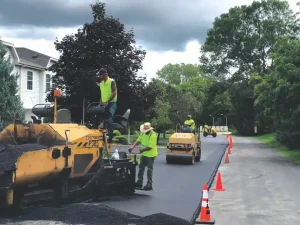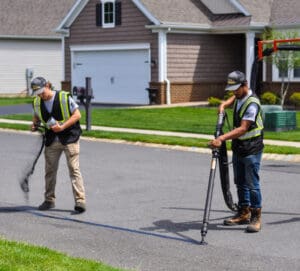When it comes to crack sealing, timing is everything. Knowing the best time to undertake this crucial maintenance task can make a significant difference in maximizing results and prolonging the lifespan of your paved surfaces. While crack sealing is typically performed during warmer months, there are a few factors to consider that go beyond just air temperature.
Surface Temperature
One essential aspect to consider is surface temperature. It’s not enough for the air temperature to be warm; the pavement itself needs to be at an optimal temperature for crack sealing. In general, experts recommend performing crack sealing when the pavement surface is at least 40°F (4°C) and rising. When the surface reaches 40°F and higher, it allows the sealant to adhere properly and form a solid bond, reducing the likelihood of cracks reopening in colder weather. This ensures that cracks are sealed effectively and prevents further damage caused by water infiltration and freeze-thaw cycles.
Additionally, performing crack sealing during warmer temperatures improves workability and enhances the durability of the sealant. It enables better flow and penetration into cracks, resulting in a more effective seal. If crack sealing is conducted during colder temperatures, it becomes challenging to achieve proper adhesion and create a durable repair.
Ambient and Underlying Moisture
Another key factor in determining when to perform crack sealing is moisture content on or beneath the pavement. To ensure optimal results, it is highly recommended to avoid performing crack sealing tasks when rain is forecasted or during periods of high humidity. These environmental conditions may impede the drying and bonding process necessary for crack sealant to create a robust and long-lasting seal. Consequently, waiting for dry weather conditions becomes essential to achieve the desired outcome.
When cracks are sealed in dry conditions, moisture interference is significantly minimized, allowing the crack sealant to adhere optimally to the asphalt or concrete surface. A thorough understanding of local weather patterns and forecasts thus becomes vital in planning and scheduling crack sealing activities effectively.
Conclusion
Considering all these factors together leads to identifying favorable windows of opportunity for crack sealing projects. By prioritizing dry weather conditions with low humidity levels and within recommended temperature ranges, one can ensure that cracks are sealed effectively without compromising durability.
Proactive planning also helps in preventing further deterioration caused by water infiltration into existing cracks. The benefits of timely crack sealing extend beyond preserving pavement integrity but also contribute significantly to preventing costly repairs or early resurfacing requirements.
Contact Pro-Pave for Help with The Best Time to Fill Cracks in Your Asphalt
Consulting a reliable paving company helps you better understand how the ambient weather affects crack sealing and when to plan filling projects.
At Pro-Pave Incorporated, we have a team of experts adequately equipped to handle your asphalt surface questions and problems. We have the skills and expertise needed to properly treat asphalt cracks and ensure the longevity of your surface.
For more information about residential and commercial paving projects, call us directly at 703-433-9500 or fill out our contact form today!



